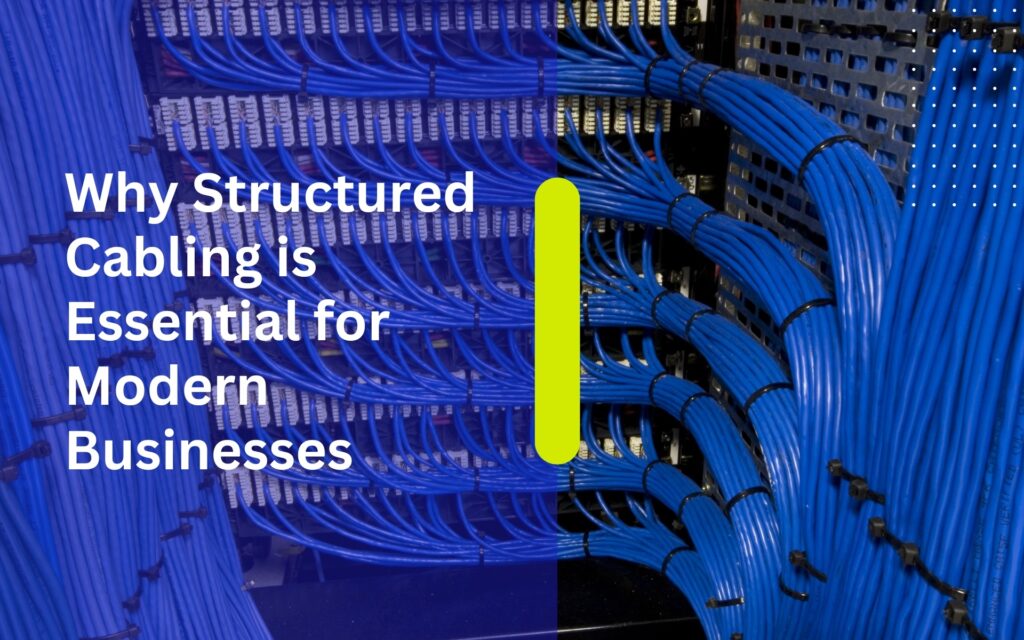CAT 6 Specs Overview. Introduction. In today’s fast-paced digital world, reliable network connectivity is no longer a luxury; it is a fundamental requirement for businesses, educational institutions, and homes. From seamless video …
Why Structured Cabling is Essential for Modern Businesses.

Introduction
In the fast-paced world of modern business, efficiency is key. Every aspect of operations, from communication to data management, plays a crucial role in maintaining competitiveness and driving growth. Among the foundational elements that often go unnoticed but are essential for seamless operations is structured cabling. As the backbone of modern IT infrastructure, structured cabling lays the foundation for reliable connectivity, streamlined operations, and future scalability. In this comprehensive exploration, we delve into the significance of structured cabling for businesses in today’s digital landscape.
Understanding Structured Cabling
Structured cabling is more than just a network infrastructure—it’s a systematic approach to organizing and connecting the various network devices and equipment within a business environment. Unlike traditional point-to-point cabling systems, structured cabling utilizes a hierarchical design that integrates a comprehensive framework of cables, connectors, and distribution panels. This organized infrastructure supports the transmission of data, voice, and multimedia signals across the network infrastructure, ensuring seamless communication and collaboration across the organization.
Reliable Connectivity: The Backbone of Business Operations
In today’s interconnected world, businesses rely heavily on connectivity to support their daily operations. Whether it’s accessing cloud-based applications, collaborating with remote teams, or communicating with clients, a stable network infrastructure is indispensable. Structured cabling provides the foundation for reliable connectivity by minimizing signal interference, reducing latency, and ensuring consistent performance across the network. With structured cabling in place, businesses can rely on a robust and resilient network infrastructure to keep their operations running smoothly.
Scalability and Flexibility: Adapting to Changing Business Needs
Businesses are constantly evolving, and so are their networking needs. One of the key advantages of structured cabling is its inherent scalability and flexibility. Unlike traditional cabling systems that can quickly become outdated or overwhelmed by growing demands, structured cabling allows businesses to easily adapt to changing requirements without the need for extensive rewiring or infrastructure overhaul. With a well-designed structured cabling system in place, businesses can seamlessly integrate new technologies, devices, and applications into their existing infrastructure, thereby future-proofing their operations and minimizing downtime.
Streamlined Operations: Simplifying Network Management
Efficiency is paramount in today’s competitive business environment, and structured cabling plays a crucial role in streamlining operations. By centralizing and organizing the network infrastructure, businesses can significantly reduce the time and resources spent on troubleshooting connectivity issues, cable management, and system maintenance. This not only enhances operational efficiency but also empowers IT teams to focus on strategic initiatives that drive business growth. With structured cabling, businesses can eliminate the chaos of tangled cables and disparate systems, creating a more organized and efficient work environment.
Cost-Effectiveness: Investing in Long-Term Success
While the initial investment in structured cabling may seem significant, it offers long-term cost savings for businesses. By standardizing the cabling infrastructure and leveraging high-quality components, businesses can minimize the risk of downtime, equipment failure, and performance degradation. Additionally, the scalability and flexibility of structured cabling reduce the need for costly infrastructure upgrades as the business expands, resulting in a lower total cost of ownership over time. By investing in structured cabling, businesses can achieve a higher return on investment and ensure the long-term success of their IT infrastructure.
Enhanced Security: Protecting Sensitive Data
In an era of increasing cyber threats, data security is a top priority for businesses of all sizes. Structured cabling plays a critical role in enhancing network security by implementing robust physical and logical safeguards. With proper cable management and access controls, businesses can mitigate the risk of unauthorized access, data breaches, and network vulnerabilities, thereby safeguarding sensitive information and preserving customer trust. By incorporating security features into the structured cabling design, businesses can create a secure and resilient network infrastructure that protects their valuable assets and minimizes the risk of cyber-attacks.
Compliance and Standards: Meeting Regulatory Requirements
Structured cabling adheres to industry standards and best practices, ensuring compliance with regulatory requirements and certifications. By following established guidelines such as those set forth by the Telecommunications Industry Association (TIA) and the International Organization for Standardization (ISO), businesses can demonstrate their commitment to quality, reliability, and performance. This not only enhances their reputation but also instills confidence among customers and stakeholders. By adhering to industry standards, businesses can ensure that their structured cabling infrastructure meets the highest levels of quality and reliability, thereby minimizing the risk of non-compliance and regulatory fines.
Conclusion
In conclusion, structured cabling is the foundation upon which modern businesses build their digital infrastructure. By providing reliable connectivity, scalability, and flexibility, structured cabling enables organizations to optimize their operations, enhance security, and drive growth in today’s competitive landscape. As businesses continue to embrace digital transformation, investing in a robust structured cabling system is not just essential but imperative for success. By prioritizing structured cabling, businesses can future-proof their operations and lay the groundwork for sustained innovation and prosperity. From reliable connectivity to enhanced security, structured cabling is the cornerstone of modern IT infrastructure, providing businesses with the tools they need to thrive in the digital age.
Related Articles
Celebrating a Year of Growth and Success at InstallersPH IT Solutions. Introduction. As the year comes to a close, InstallersPH IT Solutions takes a moment to reflect on a journey defined by …
Notice to the Public: Holiday Vacation Advisory of InstallersPH IT Solutions. Introduction. InstallersPH IT Solutions is committed to providing reliable and professional IT services to all our valued clients and partners. As …


